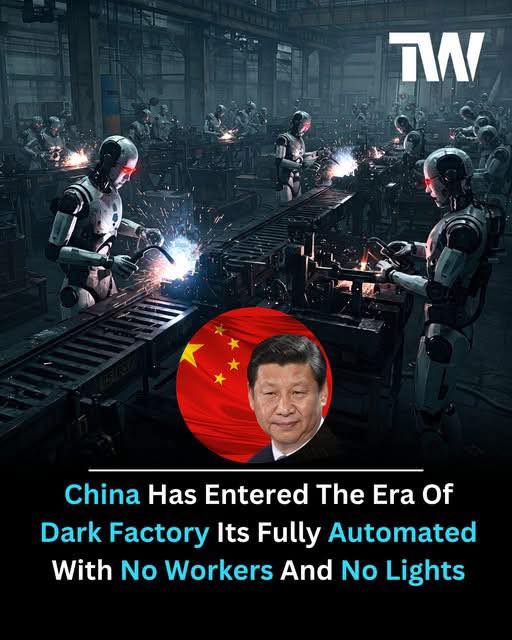In the dim silence of China’s emerging manufacturing hubs, something extraordinary is unfolding—a transformation so profound that historians may one day refer to it as the dawn of a new industrial age. These “dark factories,” as they have come to be called, are unlike anything the world has seen before. Entire production facilities operate without the presence of a single human being, their cavernous halls cloaked in perpetual darkness, not because of neglect or decay, but because lights are no longer necessary. Robots do not require illumination to function, sensors do not need sunlight to see, and algorithms do not sleep. Powered by artificial intelligence, advanced robotics, and the ever-expanding network of the Internet of Things, these factories hum with relentless precision, producing goods at speeds and levels of efficiency that make the once-vaunted assembly lines of the past look primitive. If the steam engine propelled humanity into the first industrial revolution, and electricity powered the second, automation and AI are now commanding the third—or perhaps even the fourth—revolution, with China positioned at its epicenter.
The very concept of a “factory” has long been associated with human labor—workers standing shoulder to shoulder along assembly lines, machines requiring constant supervision, managers patrolling the floor with clipboards in hand. But in the dark factory, human presence is not only unnecessary—it is seen as a liability. People get tired, make mistakes, and require wages, benefits, and safe working conditions. Machines, on the other hand, never rest, never complain, and never falter if programmed and maintained correctly. They can work 24 hours a day, 7 days a week, 365 days a year, delivering output that is consistent, precise, and free of the variability that has always been the Achilles’ heel of human-dependent manufacturing. This shift represents not just an upgrade in efficiency but a fundamental redefinition of what “production” means. In these lightless halls, the traditional barriers of time and labor no longer apply—factories have become organisms of pure productivity, immune to fatigue, immune to error, and immune to cost inflation driven by human needs.
China’s leadership in this domain is no accident. The nation has long been the workshop of the world, manufacturing everything from consumer electronics to pharmaceuticals at a scale unmatched by any other country. But the dark factory movement signals more than just continuity—it marks a transition from labor-intensive mass production to intelligence-driven automated manufacturing. By embracing dark factories, China is not only securing its dominance in global supply chains but also future-proofing its industries against the volatility of human labor markets, rising wages, and geopolitical disruptions. For decades, skeptics have predicted that China’s role as the “world’s factory” would diminish as other nations with cheaper labor—such as Vietnam, India, or Bangladesh—rose to prominence. Yet dark factories invert this logic: if machines are the new workers, then labor costs become irrelevant, and the advantage shifts to whichever nation has the capital, technological infrastructure, and political will to implement full automation at scale. And in this race, China is already far ahead.
The appeal of dark factories lies not only in their tireless productivity but also in their astonishing precision. Equipped with AI-driven quality control systems, these factories continuously monitor every step of the manufacturing process. Sensors embedded in machines detect microscopic variations in material thickness, alignment, and temperature, instantly correcting errors that would have escaped even the most experienced human inspector. Algorithms trained on terabytes of historical production data can predict when a machine part will fail before it does, scheduling maintenance in advance to prevent costly downtime. In a world where efficiency is currency, this predictive capability is a game-changer, eliminating defects, reducing waste, and ensuring that every product rolling off the line meets exacting standards. The result is not only cheaper goods but also better ones, with fewer recalls, fewer warranty claims, and fewer environmental costs associated with discarded defective products.
Moreover, dark factories are surprisingly sustainable. Traditional factories consume enormous amounts of energy not only to power machinery but also to light vast spaces and regulate air conditioning for the comfort of human workers. By eliminating the need for lighting and climate control, dark factories slash energy consumption dramatically. Robots do not sweat, and they do not need heating in the winter or cooling in the summer. Energy can be redirected toward optimizing production, and smart grids can synchronize factory demand with renewable energy availability, reducing carbon footprints across industries. In a time when climate change has become the defining global challenge, this ecological efficiency is not a trivial advantage—it is a competitive necessity. For nations striving to balance economic growth with environmental responsibility, dark factories offer a rare alignment of both goals.
The range of products emerging from these darkened halls is astonishing. From smartphones and laptops to life-saving pharmaceuticals, from household appliances to automotive components, dark factories are demonstrating their versatility. Advanced robots equipped with delicate grippers can handle fragile glass screens, while sterile robotic systems can mix chemical compounds with levels of cleanliness impossible in human-run labs. The pharmaceutical sector, in particular, stands to benefit immensely: robotic systems can operate in sterile environments without the risk of contamination, accelerating drug production during global health crises and ensuring consistent quality across millions of doses. Similarly, electronics manufacturers can churn out devices with unprecedented accuracy, ensuring that every chip, every circuit, every soldered joint is flawless.
Yet beyond the technological marvel, the rise of dark factories raises profound questions about the future of work, society, and the global economy. If factories no longer need workers, what becomes of the millions of people whose livelihoods have depended on manufacturing jobs? China itself, though at the forefront of automation, faces this dilemma acutely. For decades, its economic miracle has been fueled by the labor of hundreds of millions of workers migrating from rural villages to urban industrial zones. If machines now replace them wholesale, how will the government manage the social, economic, and political implications of mass unemployment? Some argue that displaced workers will transition into higher-value roles—design, programming, logistics, and service industries—but history suggests that such transitions are rarely smooth. Others warn of growing inequality, as the benefits of automation accrue disproportionately to corporations and capital owners while ordinary workers are left behind.
Internationally, the implications are no less seismic. Nations that once saw cheap labor as their ticket to industrial growth may find that advantage evaporating in the age of dark factories. If machines are the workers of the future, then the key variable is no longer the cost of labor but the sophistication of technology. Countries with advanced AI ecosystems, strong robotics industries, and robust digital infrastructure will thrive, while those without them may struggle to compete. The geopolitical balance of power may shift accordingly, with China, already a global economic powerhouse, consolidating its dominance as the leader of intelligent manufacturing. The United States, Europe, and Japan are all investing heavily in automation, but China’s scale, speed, and integration of state policy with industrial strategy give it a formidable edge.
Some visionaries see this transformation as liberating rather than threatening. If machines can handle the drudgery of repetitive labor, humans may finally be freed to focus on creativity, innovation, and personal fulfillment. A world of dark factories could be a world where people no longer toil in unsafe conditions, where dangerous chemical processes or backbreaking assembly work are left entirely to robots. Advocates suggest that automation could lead to a new social contract, where productivity gains from machines fund universal basic income or expanded social services, allowing societies to decouple human dignity from wage labor. The question is whether governments and corporations will choose to distribute these gains equitably—or whether they will hoard them, exacerbating inequality and social unrest.
At the cultural level, the rise of dark factories also forces us to confront deeper philosophical questions: What does it mean to live in a world where human labor is no longer essential? For millennia, work has been central to identity, purpose, and community. If machines increasingly take over not just manufacturing but potentially many forms of knowledge work as AI advances further, how will individuals and societies redefine meaning in their lives? Will we embrace a renaissance of creativity and leisure, or will we fall into despair and dislocation? The answer may depend not on the machines themselves but on the values and policies that govern their use.
What is undeniable, however, is that the dark factory revolution is no longer speculative—it is real, it is accelerating, and it is transforming the global economy before our eyes. In cities across China, vast facilities now churn out goods in silence and darkness, guided only by the glow of control panels and the soft whir of robotic arms. Supply chains are becoming faster, more resilient, and less dependent on the unpredictability of human labor. The efficiency gains are staggering, the environmental benefits tangible, and the economic implications immense. Whether celebrated as progress or feared as disruption, dark factories represent a turning point in human history—a moment when we crossed a threshold into a future where machines are not merely tools but autonomous producers.
The industrial revolutions of the past were marked by smoke, steam, and sweat; the new revolution is marked by silence, sensors, and self-learning algorithms. And while the factories of the past defined the twentieth century, the dark factories of today will define the twenty-first. As China leads the charge into this brave new world of fully autonomous, AI-driven manufacturing, the rest of the globe watches with a mix of awe, envy, and trepidation. The question is no longer whether dark factories will become the norm, but how societies, economies, and individuals will adapt to a world where machines, not humans, are the beating heart of production. In the long shadow of these lightless halls, humanity must now decide: Will we resist the future, or will we harness it to create a new vision of prosperity, purpose, and possibility?

